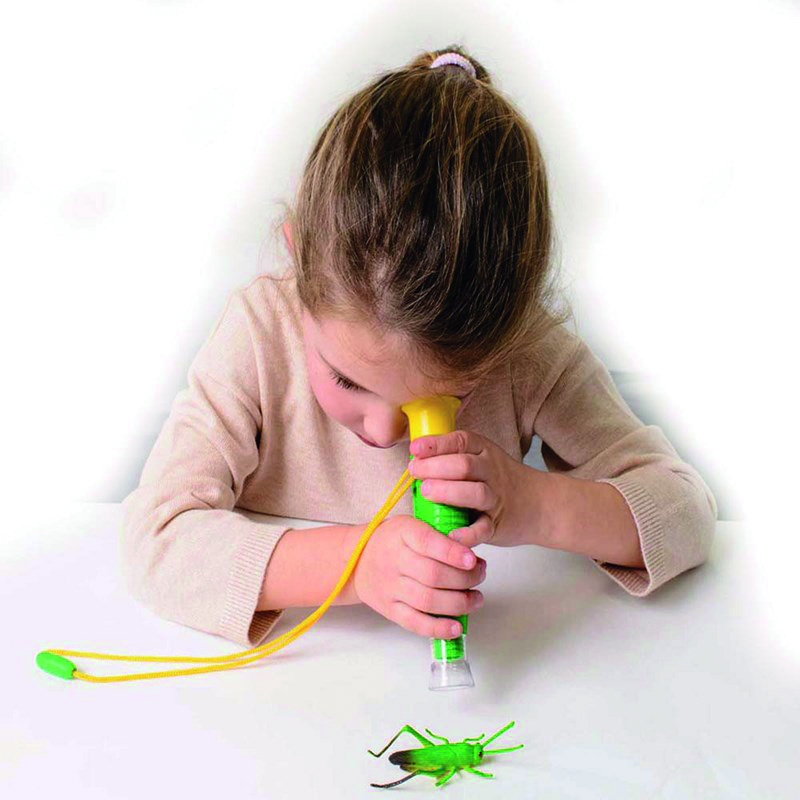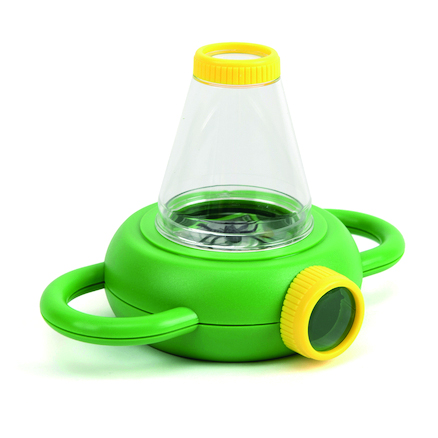
Giving young children time and space to explore both the natural and man-made world around them builds on their innate curiosity, knowledge and learning. But practitioners can take this one step further by supporting them to observe objects closely using resources such as magnifying glasses, and providing them with the knowledge that what they are doing is, actually, scientific.
Development Matters (2020) highlights early science and the need to provide children with opportunities to observe, for example:
- ‘changes in living things’
- ‘growth and decay over time’
- ‘natural processes, such as ice melting, a sound causing a vibration…’
- ‘how animals behave differently as the seasons change’.
Dr Julian Grenier, head teacher of Sheringham Nursery School and Children’s Centre, East London, led on the revised guidance and says that when it comes to early science, ‘Sometimes, we emphasise the “nature studies” aspect over all else. But Development Matters tries to provide a balance between early chemistry – mixing things together and observing changes, like cooking; early physics – using magnets, exploring forces through floating and sinking; and early biology – observing plants and living things, growing your own beans.’
Such explorations also introduce children to the scientific process. Early years consultant Jan Dubiel says, ‘Children are natural scientists and the process they use of hypothesis, experimentation and conclusion, which is a scientific process, is actually the process of effective learning, so a lot of what children do is scientific in nature and in content.’

PLAYING WITH IDEAS
Any scientific learning should be specific and accurate. Development Matters is built on Bruner’s notion of the ‘spiral curriculum’, explains Mr Grenier, and Bruner (1960) wrote of his approach, ‘We begin with the hypothesis that any subject can be taught in some intellectually honest form to any child at any stage of development.’
With this should come an accurate use of language. Mr Grenier says, ‘When pushing a piece of wood to the bottom of the water tray, ask children if they can feel the water pushing up against them and, if so, introduce the word “upthrust”.’
The role of the practitioner is to know when to allow children to play with ideas and think through things, even if they are wrong. It is equally important to make a judgement call on when to give them an answer or tell them a fact.

A CLOSER LOOK
Through magnification, practitioners can bring the world to life in a very real way and provide children with the immediate detail that they wouldn’t see otherwise.
One useful way to teach children to observe something closely is through observational drawing. For example, a practitioner could ask children to pick up an apple, smell it, examine the stalk, pips and skin, then use magnifying glasses to look closer. Once tuned into the fine details, they might start to draw it.
‘Teaching children to look and be attuned to detail and spend time exploring things is one of the most critical things educators can do,’ says Mr Dubiel. ‘It’s a real skill that has to be scaffolded, supported and taught.’
MAGNIFICATION
Here are some tips for choosing the best magnification and observation resources for your setting:
- Ensure that magnifying glasses are robust. They may get scratched and dirty.
- Make sure the lens is of good enough quality. A magnification of between 3x and 5x is ideal.
- Magnifying glasses that have a small circle with extra magnification are useful for looking at finer details.
- Show the children how to use it effectively. Some children may not have the fine motor skills to hold it the correct distance from their eyes at first. But there is a selection of different models on the market – see Resources.
- Provide a selection of magnifiers in an easily accessible tray in your continuous provision. Use them for activities alongside feathers, pine cones and shells.
- Binoculars, lightboxes and torches are useful to use alongside magnifying resources.

RESOURCES
Apps for magnification
At Sheringham Nursery School, microscopes that link to PCs have been proven to be fiddly and hard to get to work at the moment you need it – for example, when a child really wants a close-up image, Dr Grenier says.
His best resource is the magnifying app on the iPad, which is built-in as an accessibility feature. ‘This gives a pretty good level of magnification. You can see a lot of the detail on a leaf, or a worm, or on your hand,’ he says.
Other useful apps include the Magnifying Glass + Flashlight, the Cozy Magnifier & Microscope, and BigMagnifier Free. Or, buy a slide-on Phone/Tablet Magnifier, £8.49 from Cosy, which fits on most iPads, phones and screens, with 30x magnification.
Hand-held magnifiers
- The TickiT Wooden Magnifying Glass, £7.49 from Hope Education, has 2x magnification plus an inset lens with 3x magnification.
- Recordable Magnifying Glass, £17.99 from TTS, with 2x and 4x magnification.
- Jumbo Plastic Magnifying Lenses, £16.99 from TTS.
- A set of six jumbo magnifiers with x4.5 magnification, £34.70 from Hope.
Panels
- The Set of Microscope & Mirror Panels, £24.95 from Early Excellence, includes one lens panel offering 3x magnification, one plain mirror panel and one convex/concave mirror panel.
- Large Magnifier Sheet, £4.99 from Hope.
- A pack of 6 Magnification Blocks with acrylic window insets, £31.99 from Cosy.
Magnification sets
- A Magnifying Glasses set of 3 fish tanks, 6 small and 6 large magnifying glasses, 6 jar viewers and 30 pots, £41.99 from Cosy.
- A set of 9 Bug Jars and Magnifiers, £39.95 from Early Excellence.
Other useful resources
- The Two Way Magnifying Glass Jar, £8.99 from TTS, allows you to see objects from above and below.
- See and Speak Recordable Binoculars 6pk, £82.95.
- Set of 12 Binoculars 3x Magnification, £35.89 from Cosy.
- Kidnoculars, featuring focus-free viewing with 2x magnification and enlarged eye pieces, £10.99 from Hope.
- Magnify Table, £259.49 from Hope, with a magnifying lens.
- Toy Telescopes, £15.99 for 4 from Cosy.
- Rootviewer, £13.99 from Cosy.
- Ladybird Bug Jars, pack of 6, £35 from Hope, with 3.5x magnification.





Digital microscopes
Many young children will lack the eye co-ordination to use digital microscopes, but there are some hand-held versions on the market:
- Easi-Scope Microscope, £44.95 from TTS, which has 42x magnification.
- Handheld Microscope Set – Pack of ten, with 20x to 40x zoom, £72 from Hope.
CASE STUDY: Alfreton Nursery School
Alfreton Nursery School in Derbyshire has created an outdoor STEM Hive to provide a creative, natural and multisensory space in which children can think, question, explore and learn.
The enclosed space, in an unused stretch of grass in the carpark, has three pods: the Tardis, where children can explore light, shadow and colour; the Growth and Decay area; and the Philosophy for Children (P4C) pod, which is dedicated to a word or an object and is designed to invoke close thinking and discussion.
Amanda Hubball, teacher and specialist leader of education, says, ‘We wanted to create a space that could take some of the learning that takes place during Forest School, into a quieter space where children could sit and observe nature closely – and also provide more of a cognitive challenge.’
The space empowers children to investigate and test theories, with a particular focus on the future sustainability of the planet. Rolls-Royce supported the development of the 12-week focus on solids, liquids and gases, which all takes place during timetabled sessions at the Hive, when the nursery school became a finalist in the 2019 Rolls-Royce Science Prize.
Ms Hubball says, ‘We recently placed a block of ice in the P4C pod. We asked the children what it was, where it had come from and how it was made. The children then used the Hive to support them to answer the questions. They found other forms of ice and concluded that wherever there is water they found this recurrence of environmental change brought on by the temperature.’
The Hive contains magnifying glasses, binoculars, timers and mirror, which are all part of continuous provision. It also has telescopes where children can stand and do bird-watching or look up at the trees and the sky.









